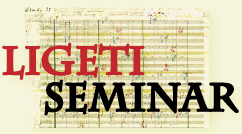1) The Early Years; Social and Political context
Introduction to the seminar. A quick and dirty introduction to pc set theory. Ligeti’s early life and works.
For week 2
Required Reading
Excerpts from ch. 2 of Rachel Beckles Willson, Ligeti, Kurtág, and Hungarian Music during the Cold War (Cambridge: Cambridge University Press, 2007), 26-41, 52-59, 64-73. on reserve LL)
Amy Bauer and Márton Kerékfy, Introduction, in György Ligeti's Cultural Identities, AmyBauer and Márton Kerékfy, eds. (London, NY: Routledge, 2017), 1–17.
Paul Griffiths, Rational and Irrational. Western Europe, 1945-50, Total Organization. Western Europe 1949-54 and Extension and Development. Western Europe 1953-57,Modern Music and After (Oxford: Oxford University Press, 2010):
Amy Bauer, "György Sándor Ligeti," Musicians and Composers of the Twentieth Century, Chris Moose, editor. (Pasadena: Salem Press, 2009), 855-60.
Listen
Analyze
Éjszaka (Night) for mixed chorus (1955)
Questions here. Due April 16
Further Reading
Amy Bauer, Early Laments (Chapter 2), Ligeti’s Laments: Nostalgia, Exoticism and the Absolute (Aldershot, UK: Ashgate), 2011.
Bianca Tiplea Temes, "Ligeti’s Romanian Concerto: From Wax Cylinders to Symphony Orchestra," Studia UBB Musica LVIII:1 (2013), 51–76.
Márton Kerékfy, "A “new music” from nothing’: György Ligeti’s Musica ricercata," Studia Musicologica 49 (2008), 203–30.
Work List
Five pieces for piano four hands (1942-43)
Polifon etüd (Polyphonic étude) and Tréfás induló (Funny march)
Three Wedding marches
Idegen földon (Far From Home; 1946)
I. Siralmas nékem (Life is so dreary)
II. Egy fekete holló (A dark raven)
III. Vissza ne nézz (Once the forest)
IV. Fjdogál a nyári szél (Summer sends a gentle breeze)
Magány (Solitude; 1946)
Bujdosó (The Fugitive; 1946)
Három Weöres-dal (Three Weöres Songs; 1946-47) LL
text
I. Gyümölcs-fürt (A Bunch of fruit)
II. “Táncol a Hold” (The Moon Dances)
III. Kalmár jött nagy madarakkal, Lento (merchant with great birds)
Two canons
Ha folyóvíz volnék (If I were river water,1947)
Pletykázo Asszonyok (Gossiping women, 1952)
Capricci Nos. 1 and 2 for piano (1947)
Invention for piano (1948)
Sonatina for piano (1950)
Sonata for violincello solo (1948-53)
Old Hungarian Ballroom Dances for string orchestra with fl and cl ad lib (1949) LL
Baladâ si joc (Ballad and dance for two violins, 1950)
Andante and allegretto for string quartet (1950) LL
Romanian concerto for orchestra (1951) LL
Musica Ricercata for piano (1951-53)
I. Sostenuto-Misurato-Prestissimo
II. Mesto, rigido e cerimoniale
III. Allegro con spirito
IV. Tempo di valse (à l'orgue de Barbarie)
V. Rubato lamentoso
VI. Allegro molto capriccioso
VII. Cantabile, molto legato
VIII. Vivace, energico
IX. (Béla Bartók in Memoriam) Adagio Mesto-Allegro Maestoso
X. Vivace. Capriccioso
XI. (Omaggio a Girolamo Frescobaldi) Andante misurato e tranquillo
Six Bagatelles for Wind Quintet (MR nos. III, II, VII, VIII, IX, X, 1953) LL
I,
II,
III,
IV,
V,
VI
Ricercare Omaggio a Frescobaldi for organ (1953)
Inaktelki nóták (Tunes from Inaktelke) (1953)
Pápainé (Widow Papai) (1953)
Metamorphoses nocturnes (String Quartet No. 1) (1953-54)
Éjszaka (Night) & Reggel (Morning) for mixed chorus (1955) LL
 print
print